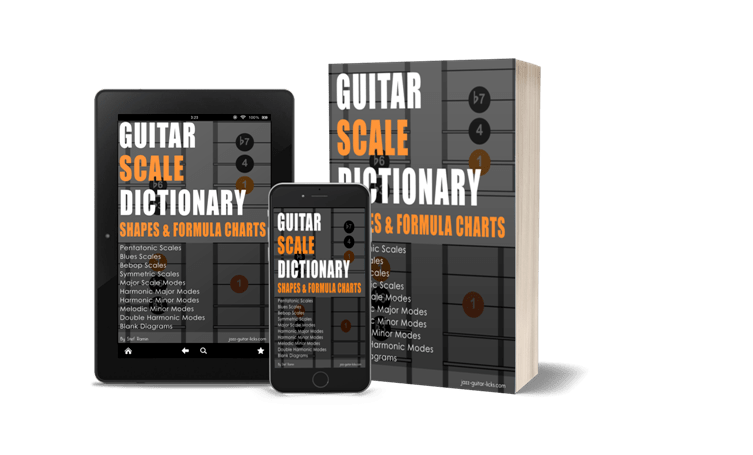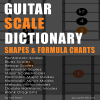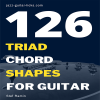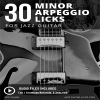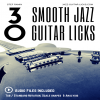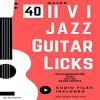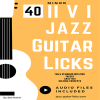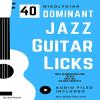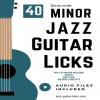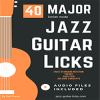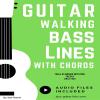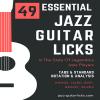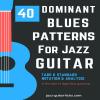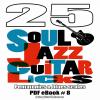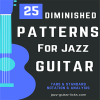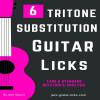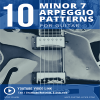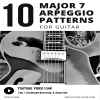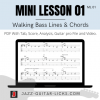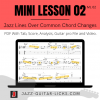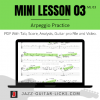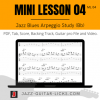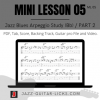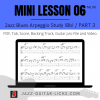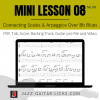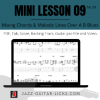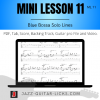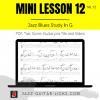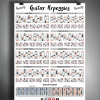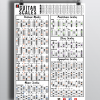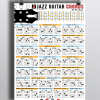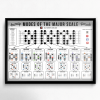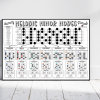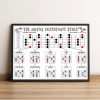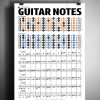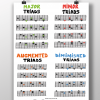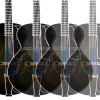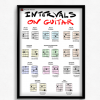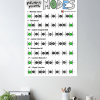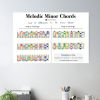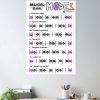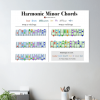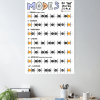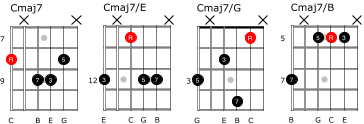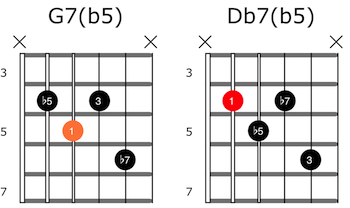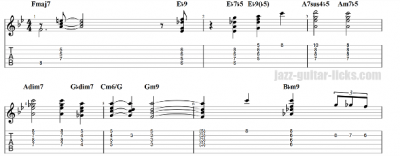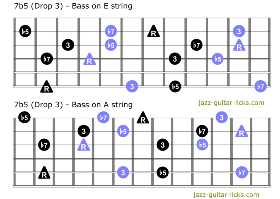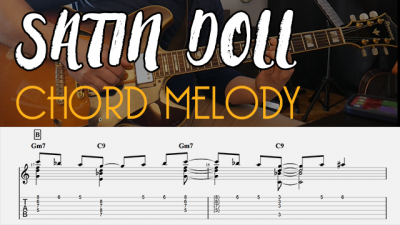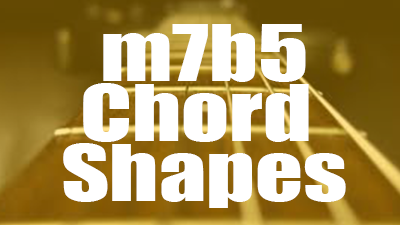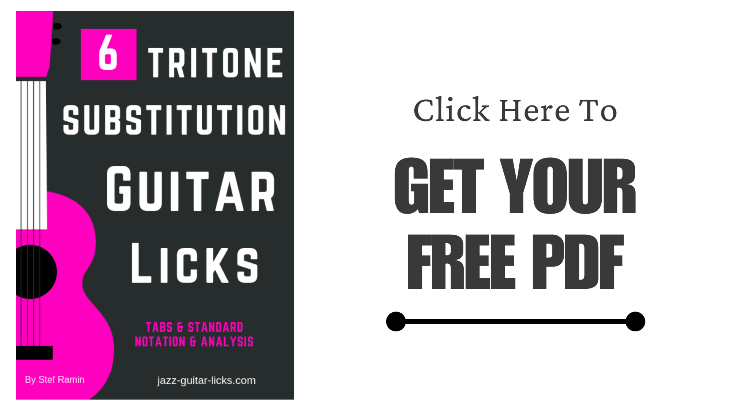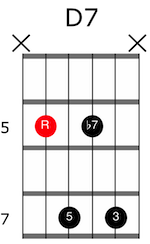
How To Identify Chords By Ear - Advices And Practice Tips For Guitar Players
- By jazz-guitar-licks
- On 2023-09-09
- In Guitar Practice Tips
- 0 comments
Identifying chords by ear is a valuable skill for any musician, especially in jazz. Here's a step-by-step guide to help you develop your ability to identify chords by ear:
1. Learn Chord Types:
Familiarize yourself with common chord types, such as major, minor, dominant 7th, diminished, half-diminished and augmented chords. Understand how these chords are constructed and how they sound should be an important step of your daily guitar practice routine.
Chords are built by combining different notes from a scale in specific intervals. Here's a brief recap with basic guitar shapes of how common chord types are constructed:
1. Major Chords:
- Root note (R)
- Major third (4 half steps above the root)
- Perfect fifth (7 half steps above the root)
 2. Minor Chords:
2. Minor Chords:
- Root note
- Minor third (3 half steps above the root)
- Perfect fifth (7 half steps above the root)
 3. Dominant 7th Chords:
3. Dominant 7th Chords:
- Root note
- Major third (4 half steps above the root)
- Perfect fifth (7 half steps above the root)
- Minor seventh (10 half steps above the root)
 4. Half-Diminished Chord (Minor 7th Flat 5):
4. Half-Diminished Chord (Minor 7th Flat 5):
- Root note
- Minor third (3 half steps above the root)
- Diminished fifth (6 half steps above the root)
- Minor seventh (10 half steps above the root)

5. Diminished Chords:
- Root note
- Minor third (3 half steps above the root)
- Diminished fifth (6 half steps above the root)
 6. Augmented Chords:
6. Augmented Chords:
- Root note
- Major third (4 half steps above the root)
- Augmented fifth (8 half steps above the root)
 7. Minor 7th Chords:
7. Minor 7th Chords:
- Root note
- Minor third (3 half steps above the root)
- Perfect fifth (7 half steps above the root)
- Minor seventh (10 half steps above the root)
 8. Major 7th Chords:
8. Major 7th Chords:
- Root note
- Major third (4 half steps above the root)
- Perfect fifth (7 half steps above the root)
- Major seventh (11 half steps above the root)
 9. Diminished 7th Chords:
9. Diminished 7th Chords:
- Root note
- Minor third (3 half steps above the root)
- Diminished fifth (6 half steps above the root)
- Diminished seventh (9 half steps above the root)

10. Extended Chords (9th, 11th, 13th):
- Extended chords are built on the basic major or minor chord structures by adding additional notes, typically in thirds above the root.
Remember that these intervals are counted in terms of half steps (also known as semitones), and the root note is the starting point for building any chord.
The specific combination of intervals determines the quality and sound of the chord. Experimenting with different chord types and inversions on your guitar will help you understand their sonic characteristics better.
2. Focus on Root Notes:
Start by identifying the root note of the chord. The root note is the foundation of the chord and often the easiest to identify.
The root note is the foundational or fundamental pitch upon which a chord (or scale) is built. It serves as the reference point for the entire musical structure. In both chords and scales, the root note provides the tonal center, defining the key or tonality of the music.
In a chord:
- The root note is the note that gives the chord its name.
- It's the starting point from which the other notes in the chord are determined.
- The relationship of the other notes to the root note determines the chord's quality (major, minor, diminished, etc.).
For example, in a C major chord:
- The root note is C.
- The other notes (E and G) are built around the root note, creating the C major triad.
3. Hear The Quality:
Pay attention to the quality of the chord (major, minor, dominant, etc.).
Focus on the third interval (whether it sounds "happy" or "sad"). There are two types of third intervals: major thirds and minor thirds.
- Major Third: A major third consists of two notes that are four half steps or two whole steps apart. It is generally considered to have a brighter or happier sound. For example, the interval from C to E is a major third.
- Minor Third: A minor third consists of two notes that are three half steps or one and a half whole steps apart. It is often associated with a sadder or more somber quality. For example, the interval from C to E♭ is a minor third.
Focus on the seventh interval (whether it sounds "resolved" or "tense"). The seventh interval can refer to two primary intervals: the major seventh and the minor seventh.
- Major Seventh (M7): The major seventh interval consists of 11 half steps or five whole steps between two notes. It often creates a sense of tension or dissonance in music and is typically heard as requiring resolution to a more stable sound. For example, the interval from C to B is a major seventh, and it can create a feeling of tension that wants to resolve, usually by moving the B up to a C or down to a B♭.
- Minor Seventh (m7): The minor seventh interval consists of 10 half steps or five whole steps between two notes. It can also generate tension in music but is sometimes used in a way that feels less dissonant than the major seventh. Whether it sounds tense or not depends on the musical context. For example, the interval from C to B♭ is a minor seventh.
The perception of tension and resolution is often influenced by the surrounding chords, melodies, and harmonic progressions. Major sevenths are typically heard as more dissonant and in need of resolution compared to minor sevenths.
4. Train Your Ear:
Use online resources or apps that provide chord ear training exercises. These tools play chords, and you need to identify their types. As you practice, you'll become more attuned to the nuances of each chord.
Here is a brief list of websites proposing ear training exercises:
- https://www.teoria.com/en/exercises/
- https://www.iwasdoingallright.com/tools/ear_training/online/
- https://www.earbeater.com/online-ear-training/#/
5. Listen to Chord Progressions:
Listen to songs or recordings with clear chord progressions. Try to identify the chords as they change. Start with simple songs and progress to more complex ones.
6. Use Visual Aids:
Visual aids like chord charts can help you associate the sound of a chord with its appearance on paper. This can aid in developing a mental connection between the auditory and visual aspects of chords.
7. Practice with Familiar Songs:
Choose songs or jazz standards you're familiar with and try to identify the chords by ear. Start with songs that have relatively simple chord progressions before moving on to more intricate tunes.
8. Isolate Chords:
Isolate chord changes in a song and practice identifying them one by one. This can help you focus on the specific sound of each chord.
9. Sing Along:
Sing the notes of each chord as you listen. This can help you internalize the chord's sound and make it easier to identify.
10. Use Your Instrument:
Play along with recordings, attempting to match the chords you hear. This hands-on approach can help you develop a tactile connection to chord sounds.
11. Start Slow, Build Confidence:
At first, you might only identify basic chords. Over time, your accuracy and speed will improve and then you'll be able to start hear and regognize more complex chords. Don't get discouraged; this skill takes time to develop.
12. Analyze Music:
As you listen to more complex jazz recordings, try to analyze the chords used in the context of the song. This can deepen your understanding of chord progressions and their functions.
13. Seek Feedback:
Play chords for someone else or ask a more experienced musician to play chords for you. They can provide feedback and help you refine your chord recognition skills.
Remember that consistent practice is key. Ear training is a gradual process, and improvement comes with time and patience. Over time, your ability to identify chords by ear will become more accurate and intuitive.
-
Guitar Scale Dictionary
This E-book is a printable PDF method including over 700 scale diagrams and formula charts for guitarists. -
Guitar Chord Dictionary
This PDF eBook provides over 550 guitar chord shapes. This is the perfect reference guide to understand how chords are built and how to play them on the guitar neck. -
172 Arpeggio Shapes For Guitar
This printable PDF is a method dedicated to guitarists of all styles who want to learn build and play the most important types of arpeggios. -
126 Triad Chord Shapes
This handbook for guitar players is intended both for teachers and students. It includes 126 guitar shapes for mastering triads. -
Harmonic Major Scale Chords
this PDF offers diagrams and tabs for guitar to learn the chords of the harmonic major scale. -
Major Scale Harmonization
This package provides a printable PDF with exercises and audio files to learn how to harmonize the major scale with 3 note chords and their extensions. -
30 Minor Arpeggio Licks
This package includes a printable PDF method containing 30 exercises with tabs, staves and audio files for practicing minor arpeggios on guitar. -
II V I Bundle - 170 Exercises
This bundle contains 4 PDF methods for a total of 170 exercises with tabs, staves, analysis & audio files for practicing scales, arpeggios licks & chords over the 2-5-1 progression. -
Diatonic Licks Bundle
This package contains 120 jazz guitar lines based on diatonic modes as Mixolydian, Dorian and Ionian. PDF format with tabs, audio files and analysis. -
30 Groovy Jazz Guitar Licks
This downloadable package contains a PDF WITH audio files giving access to 30 groovy guitar phrases mixing jazz, blues and funky licks for beginners. -
30 Smooth Jazz Guitar Licks
In this package you'll get a printable PDF Method with tabs, notation, analysis, scale shapes and audio files for practicing 30 smooth jazz guitar licks. -
40 II V I Jazz Guitar Licks
This pdf method for guitar contains fourteen 2 5 1 jazz guitar lines with tab, standard notation, analysis, scale charts and audio files. -
50 II-V-I voicings
This printable PDF guitar method provides 50 exercises with audio files, analysis, tab and staves for learning major 2-5-1 chord voicings. -
40 Minor 2 5 1 Chord Voicings
This PDF method contains 40 exercices with tabs, scores and audio files for practicing jazz guitar chords over the minor 2 5 1 progression. -
40 Minor II V I Licks
This guitar method is a printable PDF with tabs, diagrams, theory and audio files providing 40 minor 2 5 1 jazz patterns. -
40 Mixolydian Jazz Guitar Lick
PDF guitar method with tabs, audio files and theory providing 40 dominant jazz guitar lines for teachers and students. -
40 Minor Jazz Guitar Licks
This printable guitar method in PDF format contains 40 easy minor jazz guitar lines based on the Dorian mode. -
40 Major Jazz Guitar Licks
Printable PDF eBook method containing 40 major jazz guitar licks with tab, standard notation and audio files for beginners and intermediates. -
Guitar Walking Bass Lines
This jazz guitar method about walking bass lines and chords is available as a PDF files containing 35 exercises with tabs, analysis and audio files -
101 Dominant Arpeggio Patterns
This printable PDF method provides 101 dominant arpeggio exercises with tab, theory and standard notation for the jazz, blues and rock guitarist. -
49 Essential Jazz Lines
This printable eBook method in PDF format provides 49 jazz solo transcriptions of the greatest jazz musicians. Tab, standard notation, audio files & analysis. -
11 Jazz Blues Studies
11 jazz blues chord studies with tabs, standard notation, analysis, and audio recordings and PDF. -
10 Easy Fingerstyle Blues
This PDF with Tabs and audio files provides 10 easy acoustic fingerstyle blues guitar studies for kids and beginners. -
25 Altered Jazz Guitar Lines
This PDF eBook method contains 25 altered jazz guitar licks with tabs, patterns, scale charts and audio files to master, apply and develop the altered scale. -
40 Blues Dominant Patterns
This printable method is available as a PDF file containing 40 easy dominant jazz-blues guitar lines with tabs, standard notation, analysis, audio files and scale charts. -
25 Pentatonic Licks
This jazz guitar method is an eBook available as a PDF with standard notation, guitar tabs, diagrams, analysis, audio files and backing tracks. You will find in this booklet 25 easy jazz guitar lines with theory using common and rare pentatonic scales. -
25 Soul Jazz Guitar Licks
You will find here an eBook available in PDF containing 25 soul jazz and hard bop guitar licks in the style of Grant Green, Melvin Sparks, George Benson. -
25 Diminished Patterns
This eBook PDF with audio files contains 25 dominant diminished jazz guitar patterns using the half-whole diminished scale and diminished 7th arpeggios. -
6 Tritone substitution licks
This Printable PDF eBook available for free download contains 6 easy jazz guitar licks with tabs/notation, youtube video link and analysis about the tritone substitution. -
10 Minor 7 Arpeggio Patterns
This printable PDF eBook offers 10 easy minor 7 arpeggio patterns with its related YouTube video for beginner guitarists. -
10 Easy Major 7 Arpeggio Licks
This is a printable PDF for beginner jazz guitar players providing 10 easy licks to practice major 7 arpeggios. -
10 Chord Melody Lines
Within this package, you'll discover a set of ten chord melody exercises for beginners. Printable PDFaudio files, a backing track, and a link to the associated YouTube video. -
10 Minor Blues Scale Licks
You'll find here a PDF with 10 easy jazz guitar licks to practice the minor blues scale on guitar.
-
Mini Lesson 01 (ML 01)
You'll find a mini guitar lesson about walking bass lines and chords containing a PDF with tab, score analysis, shapes, a video and a guitar pro file. -
Mini Lesson 02 (ML 02)
In this mini jazz guitar lesson you will learn how to play easy and cool jazz lines over basic chord changes found in jazz. Pdf, tab and video included. -
Mini Lesson 03 (ML 03)
With this short lesson you will learn how to play and connect basic guitar arpeggios over a diatonic chord progression. -
Mini Lesson 04 (ML 04)
This is a downloadable package with PDF, Tab, guitar pro file and video to practice guitar arpeggios over a jazz blues chord progression. -
Mini Lesson 05 (ML 05)
This downloadable package provides a PDF with Tab/score, a guitar pro file and a short video for practicing guitar arpeggios on a jazz blues progression in Bb. -
Mini Lesson 06 (ML 06)
This package for guitarists contains a PDF with tab, video, backing track and guitar pro file for practicing arpeggios over a basic jazz blues progression. -
Mini Lesson 07 (ML 07)
With this mini guitar lesson you will learn how to superimpose arpeggios over a diatonic chord progression. Video, pdf, jamtrack and guitar pro file included. -
Mini Lesson 08 (ML08)
Mini lesson with PDF, guitar pro file, video and backing track for practicing scale and arpeggio connections over a Bb jazz blues progression. -
Mini Lesson 09 (ML09)
This mini lesson is a downloadable package containing a PDF, video, backing track and guitar pro file of a jazz blues progression study in B. -
Mini Lesson 10 (ML 10)
This mini guitar lesson provides a printable PDF with tab/notation, video, backing track and guitar pro file for practicing open triads over Fly Me To The Moon. -
Mini Lesson 11 (ML 11)
This guitar lesson is a package inlcuding a PDF transcription with analysis, a short video, a backing track and a guitar pro file to learn to play jazz solo lines over Blue Bossa. -
Jazz Blues Guitar Study (ML12)
This mini lesson provides a video, a guitar pro file and PDF transcription of a jazz blues study in G implying melodic lines, chord extensions and substitutions
-
Guitar Arpeggios Poster
This giant guitar poster for any guitar player, student or instructor contains colorful arpeggio diagrams. Giant size 24 x 36 inches (60 x 90 cm). -
Guitar Scales Poster 24*36
Guitar posters and wall art with eighteen neck diagrams representing the most used scales in music. -
Guitar Chord Poster
This printed color posters contains 63 guitar chord diagrams for jazz players, students, teachers and schools. -
Guitar Modes Poster
Guitar reference posters and wall art about modes of the major scale for guitar teachers, students and music schools. -
Melodic Minor Modes Poster
Educative and decorative giant guitar poster with neck diagrams, interval names about the seven modes of the melodic minor scale. -
Pentatonic Scale Guitar Poster
This guitar reference poster shows the positions and intervals of the major pentatonic scale. -
Guitar Notes Poster
This is a giant poster showing the notes on the guitar fret board and their positions on a musical staff. -
Triads Guitar Poster
This reference poster show the positions and intervals of the main triads used on guitar. This is a useful tool for guitarists, teacher and students. -
Four Archtop Guitars Poster
This is a decorative poster with four archtop jazz guitars. Several size and colors in landscape format available on Teespring and redbubble. -
Intervals On Guitar - Poster
This giant poster for guitar provides neck diagrams with interval positions. -
Melodic Minor Modes
This music theory poster available in several sizes shows the construction of the seven modes of the melodic minor scale. -
Major Scale Chords
This handy poster provides a clear visual guide to the chords built from the major scale, helping you recognize patterns and improve your playing. -
Melodic Minor Chords
Explore the rich harmonic possibilities of the melodic minor scale with this essential guitar poster. -
Harmonic Minor Modes
This music theory poster, offered in various sizes, demonstrates the structure of the seven modes of the melodic minor scale. -
Harmonic Minor Chords
Discover the chords of the harmonic minor scale with this guitar poster. -
Major Scale Modes
This poster is created for music teachers and students, illustrating the structure of the seven modes of the major scale.
ear training chords harmony practice tips
Add a comment
